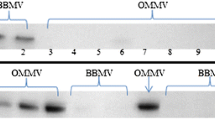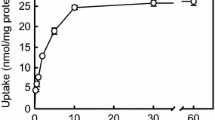Abstract
In order to study the quantitative structure/activity relationship of organic cation transport across the contraluminal side of the proximal renal tubule cell, the stopped-flow capillary microperfusion method was applied and the inhibitory potency (apparent K i values) of different homologous series of substrates against N 1-[3H]methylnicotinamide (NMeN+) transport was evaluated. Aniline and its ring- or N-substituted analogues as well as the aminonaphthalines do not interact with the contraluminal NMeN+ transporter except for the quaternary trimethylphenylammonium and pararosaniline, which bear a permanent positive charge, and for 1,8-bis-(dimethylamino)naphthaline, which forms an intramolecular hydrogen bond. If, however, one or more than one methylene group is interposed between the benzene ring and the amino group, the compounds interact with the contraluminal NMeN+ transporter in proportion to their hydrophobicity parameter, i.e. the octanol/water partition coefficient (log octanol). The catecholamines and other hydroxyl-substituted phenylethyl analogues also follow this rule. In addition, the N-heterocyclic pyridine, quinoline, isoquinoline and acridine analogues also interact with the contraluminal NMeN+ transporter, when their pK a values are higher than 5.0, and, an inverse correlation between pK a and log K i, NMeN was observed. An exception to this rule are those hydroxy compounds of pyridine, quinoline and isoquinoline that show tautomerism. These compounds slightly inhibit NMeN+ transport despite low pK a values. The quaternary nitrogen compounds of aniline and the N-heterocyclic analogues, as far as tested, all interact with the contraluminal NMeN+ transporter in relation to their hydrophobicity. The data indicate that the contraluminal NMeN+ transporter interacts with N-compounds according to their hydrophobicity and/or according to their basicity (affinity to protons). The reason for deviation of the aniline analogues and the OH-tautomeric heterocyclic N-compounds from this behaviour is discussed.
Similar content being viewed by others
References
Baines AD, Craan A, Chan W, Morgunov N (1978) Tubular secretion and metabolism of dopamine, norepinephrine, methoxytyramine and normetanephrine by the rat kidney. J Pharmacol Exp Ther 208:144–147
Ball SG, Gunn IG, Douglas IHS (1982) Renal handling of dopa, dopamine, norepinephrine, and epinephrine in the dog. Am J Physiol 242:F56-F62
Bradley T, Hjemdahl P (1986) Renal extraction of endogenous and radiolabelled catecholamines in the dog. Acta Physiol Scand 126:505–510
Esler M, Jennings G, Lambert G, Meredith I, Horne M, Eisenhofer G (1990) Overflow of catecholamine neurotransmitters to the circulation: source, fate, and functions. Physiol Rev 70:963–985
Fouda AK, Fauth C, Roch-Ramel F (1990) Transport of organic cations by kidney epithelial cell line (LLC-PK1). J Pharmacol Exp Ther 252:286–292
Fritzsch G, Haase W, Rumrich G, Fasold H, Ullrich KJ (1984) A stopped flow capillary perfusion method to evaluate contraluminal transport parameters of methylsuccinate from interstitium into renal proximal tubular cells. Pflügers Arch 400:250–256
Hansch C, Leo A (1979) Substituent constants for correlation analysis in chemistry and biology. Wiley, New York
Inui K, Takano M, Okano T, Hori R (1986) Role of chloride on carrier-mediated transport of p-aminohippurate in rat renal basolateral membrane vesicles. Biochim Biophys Acta 855:425–428
Kosoglou T, Vlasses PH (1989) Drug interactions involving renal transport mechanism: an overview. DICP, The annals of pharmacotherapy 23:116–122
Lappe RW, Henry DP, Willis LR (1980) Mechanism of renal tubular secretion of norepinephrine in the rabbit. J Pharmacol Exp Ther 215:443–449
Liftschitz MD, Keller D, Godfien A, Schrier RW (1973) Mechanism of renal clearance of isoproterenol. Am J Physiol 224:733–736
Link L, Weidmann P, Probst P, Futterlieb A (1985) Renal handling of norepinephrine and epinephrine in the pig. Pflügers Arch 405:66–69
Mack F, Bönisch H (1979) Dissociation constants and lipophilicity of catecholamines and related compounds. Naunyn-Schmiedeberg's Arch. Pharmacol 310:1–9
McKinney TD, Speeg KV (1982) Cimetidine and procainamide secretion by proximal tubules in vitro. Am J Physiol 242:F672-F680
Perrin DD (1965) Dissociation constants of organic bases in aqueous solution. Butterworth, London
Pritchard JB (1988) Coupled transport of p-aminohippurate by rat basolateral membrane vesicles. Am J Physiol 255:F597-F604
Quebbemann AJ, Rennick BR (1969) Effects of structural modifications of catecholamines on renal tubular transport in the chicken. J Pharmacol Exp Ther 166:52–62
Rankin GO, Yang DJ, Cressey-Veneziano K, Casto S, Wang RT, Brown PI (1986) In vivo and in vitro nephrotoxicity of aniline and its monochlorophenyl derivatives in the Fischer 344 rat. Toxicology 38:269–283
Rennick BR (1976) Proximal tubular transport and renal metabolism of organic cations and catechol. In: Martinez-Maldonado M (ed.) Methods in pharmacology, renal pharmacology, vol 4A, pp 335–356
Rennick BR (1981) Renal tubular transport of organic cations. In: Greger R, Lang F, Silbernagl S (eds) Renal transport of organic substances. Springer, Berlin pp 178–188
Reynard AM (1968) The reversible and irreversible inhibition of N 1-methylnicotinamide uptake into rat kidney cortex slices. J Pharmacol Exp Ther 163:461–467
Silva P, Landsberg L, Besarab A (1979) Excretion and metabolism of catecholamines by the isolated perfused rat kidney. J Clin Invest 64:850–857
Sober HA (1968) Ionization constants of acids and bases. Handbook of biochemistry, selected data for molecular biology. Chemical Rubber Co., Cleveland, Ohio
Sokol PP, Holohan PD, Ross CR (1987) The neurotoxins 1-methyl-4-phenyl-pyridinium and 1-methyl-4-phenyl-1,2,3,6-tetrahydropyridine are substrates for the organic cation transporter in renal brush border membrane vesicles. J Pharmacol Exp Ther 242:152–157
Sokol PP, Holohan PD, Ross CR (1990) Acridine orange transport in canine renal brush border membrane vesicles. Biochem Pharmacol 40:1421–1424
Staab HA, Saupe T (1988) “Proton sponges” and the geometry of hydrogen bonds: aromatic nitrogen bases with exceptional basicities. Angew Chem Int Ed Engl 27:865–879
Ullrich KJ, Rumrich G (1990) Kidney: Microperfusion — double-perfused tubule in situ. Methods Enzymol 191:98–107
Ullrich KJ, Rumrich G, Klöss S (1988) Contraluminal para-aminohippurate (PAH) transport in the proximal tubule of the rat kidney: IV. Specificity: mono- and polysubstituted benzene analogs. Pflügers Arch 413:134–146
Ullrich KJ, Papavassiliou F, David C, Rumrich G, Fritzsch G (1991) Contraluminal transport of organic cations in the proximal tubule of the rat kidney: I. Kinetics of N1-methylnicotinamide and tetraethylammonium; influence of K+, HCO −3 , pH; inhibition by aliphatic primary-, secondary-, tertiary amines, mono- and bisquaternary compounds. Pflügers Arch 419:84–92
Ullrich KJ, Rumrich G, Neiteler K, Fritzsch G (1991) Contraluminal organic cation transport in rat cortical tubules: influence of hydrophobicity and pK a values of the substrates. Pflügers Arch 418, R65
Weiner IM (1973) Transport of weak acids and bases. In: Orloff J, Berliner RW, Geiger SR (eds) Handbook of physiology: section 8. Renal physiology. American Physiology Society, Washington, pp 521–554
Werner D, Roch-Ramel F (1991) Indirect Na+ dependency of urate and p-aminohippurate transport in pig basolateral membrane vesicles. Am J Physiol 261, F265-F272
Author information
Authors and Affiliations
Rights and permissions
About this article
Cite this article
Ullrich, K.J., Rumrich, G., Neiteler, K. et al. Contraluminal transport of organic cations in the proximal tubule of the rat kidney. Pflugers Arch. 420, 29–38 (1992). https://doi.org/10.1007/BF00378638
Received:
Revised:
Accepted:
Issue Date:
DOI: https://doi.org/10.1007/BF00378638




